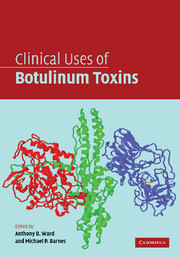Book contents
- Frontmatter
- Contents
- List of Contributors
- 1 Introduction
- 2 Mechanistic basis for the therapeutic effectiveness of botulinum toxin A on over-active cholinergic nerves
- 3 Botulinum toxin: from menace to medicine
- 4 Botulinum toxin: primary and secondary resistance
- 5 Introduction to botulinum toxin in clinical practice
- 6 Cervical dystonia
- 7 The use of botulinum toxin in otolaryngology
- 8 Spasticity
- 9 Hyperhidrosis
- 10 Hypersalivation
- 11 Botulinum toxin type A for the prophylactic treatment of primary headache disorders
- 12 Botulinum toxin in the management of back and neck pain
- 13 Clinical uses of botulinum toxin
- 14 Bladder and bowel indications
- 15 Cosmetic uses of botulinum toxin A
- 16 Other clinical neurological uses of botulinum toxin
- Index
- Plate section
- References
8 - Spasticity
Published online by Cambridge University Press: 02 December 2009
- Frontmatter
- Contents
- List of Contributors
- 1 Introduction
- 2 Mechanistic basis for the therapeutic effectiveness of botulinum toxin A on over-active cholinergic nerves
- 3 Botulinum toxin: from menace to medicine
- 4 Botulinum toxin: primary and secondary resistance
- 5 Introduction to botulinum toxin in clinical practice
- 6 Cervical dystonia
- 7 The use of botulinum toxin in otolaryngology
- 8 Spasticity
- 9 Hyperhidrosis
- 10 Hypersalivation
- 11 Botulinum toxin type A for the prophylactic treatment of primary headache disorders
- 12 Botulinum toxin in the management of back and neck pain
- 13 Clinical uses of botulinum toxin
- 14 Bladder and bowel indications
- 15 Cosmetic uses of botulinum toxin A
- 16 Other clinical neurological uses of botulinum toxin
- Index
- Plate section
- References
Summary
Introduction
Spasticity is a physiological consequence of an insult to the brain or spinal cord, which can lead to life-threatening, disabling and costly consequences. This typically occurs in the following patients following stroke, brain injury (trauma and other causes, e.g. anoxia, post-neurosurgery), spinal cord injury, multiple sclerosis and other disabling neurological diseases, and cerebral palsy. Its current management has been advanced considerably over the last ten years by new thinking and by new drugs and technology. Lance's definition of 1980 is still relevant and the impairment is classified as one of the movement disorders. It is important therefore to stress when teaching on this topic, in order to highlight the need for patients' spasticity to be assessed while they are functioning. The fact that many attempts have been made to define it shows the degree of its complexity, but Young described spasticity as part of the upper motor neuron syndrome and gave a definition as a velocity-dependent increase in muscle tone with exaggerated tendon jerks resulting in hyper-excitability of the stretch reflex in association with other features of the upper motor neuron syndrome.
He also described spastic dystonia and spastic paresis, which are somewhat contentious terms, but do highlight the positive and negative features of the upper motor neuron syndrome and these are set out in Table 8.1. Essentially, if left untreated following damage to the brain or spinal cord, it is characterized by muscle overactivity and high-tone spasms and will lead to muscle and soft tissue contracture.
- Type
- Chapter
- Information
- Clinical Uses of Botulinum Toxins , pp. 122 - 174Publisher: Cambridge University PressPrint publication year: 2007

